Let’s be honest, a pool is a great fun feature for the whole family but what’s the point of having a pool if you can’t show it off? Pool paint is still one of the most popular and cheaper ways to cover your pool surface. It provides a clean and crisp environment for your pool come party time. Over time, paint will fade and in some cases, bubble, and what was once your beautiful backyard pool has become what looks like a bad summer neighborhood hangout.
Sometimes this happens due to negligence or simple forgetfulness. Sometimes, you inherit these problems when you purchase a new home. Regardless of how the problems arose, the main goal is to get your pool in pool-party shape. After helping thousands of customers, we’ve compiled the most common problems pool owners encounter with their painted pools.
Blistering/Bubbling
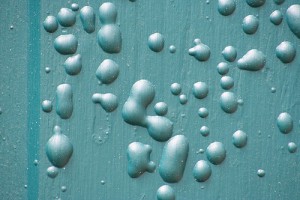
Blistering is the formation of little bubbles along the surface of your pool paint. There are two different causes to blistering, heat and moisture. Whenever you paint your pool, you should always follow the manufacturer’s guidelines from start to finish. Painting your pool in direct sunlight, on a warm surface, causes heat blisters. What’s happening is, the film dries too quickly, trapping solvents inside. These solvents then vaporize, forcing pressure against the top coat of the paint causing blistering. This is more common in darker colors, as they absorb heater a lot faster than lighter ones.
Blistering can also be caused by moisture. The major cause of exterior paint blistering is the interior moisture in tightly constructed homes. In essence, there is no place for this moisture to escape but through the walls. During the summer, the sun heats the side and the water trapped behind the paint eventually evaporates. Again, causing bubbles.
Solution
Before you’re able to fix the bubbles, you first have to determine which type of blister you have: one caused by heat or moisture? Break open one of the bubbles. If you see another layer of paint, the bubble was probably caused by heat. If it is bare, then moisture is probably the culprit. In both cases, sand and scrape peeling paint to bare, prime exposed areas, and repaint.
In heat blistering, the prime coat is generally not affected and can simply be repainted without priming.

Cratering/ Foaming
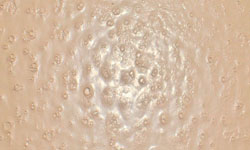
Craters are tiny depressions in dried paint film. They are caused by trapped pockets of air in wet paint film. These depressions can occur shortly after the immediate coat or topcoat has been applied. They are also caused by excessively stirring or shaking the paint before applying, using an incorrect roller, applying too many coats, or applying paint to a porous unprimed surface.
Solutions
All craters should be sanded out and surface repainted. If they are not removed before the new coat is applied, the craters will still show through. When using new rollers, completely immerse them in paint and roll them out a few times before using. This expels all the extra air in the brush. Do not repeatedly shake your paint cans. After a can has been shaken, let it sit until all the bubbles and foam disappear.
Alligatoring
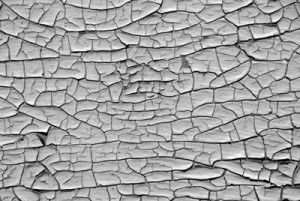
Alligatoring is the term that describes when the surface painted is cracked and develops an appearance that resembles the skin of an alligator. Alligatoring is caused when the topcoat fails to bond smoothly to the coat beneath. Sometimes a glossy finish is quite difficult to provide a good, necessary bond. Adversely, applying an extremely hard coating over a softer primer can also result in alligatoring.
Solutions
Completely remove old paint by scraping and sanding. Power washing can be used for larger areas. Next, prime the area with a high quality latex or an oil primer and paint with either oil or acrylic latex house paint.
Brush Marks
Brush marks are marks that are left imprinted in the dried paint film. They are caused by poor quality applicators. If the filament of a brush is not finished properly, it will leave marks. Other causes include: top-porous surface, applying too little paint, using the wrong type of thinner, not allowing the paint to dry in between coats.
Solutions
Whenever possible, always use top-quality applicators. Your brush should contain bristles that are properly flagged and tipped. First smooth surfaces by sanding before repainting. If you see that the surface is still too porous, apply a primer before repainting.

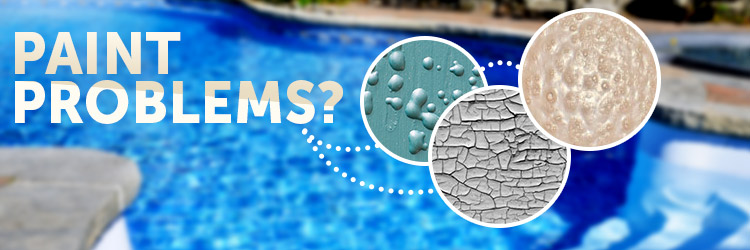
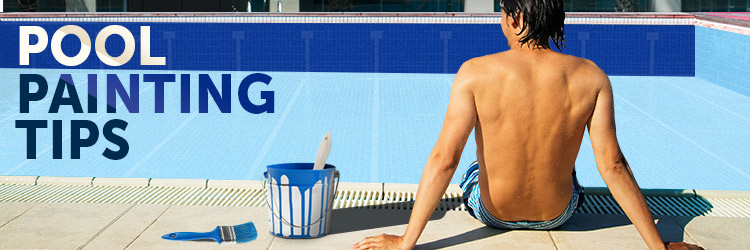






Swimming pools are built to hold the weight of a lot of water depending in your pools size. When you drain it, it is unbeknownst to you changing shape. Micro cracks are developing trapping water or other wet materials. So u paint it. Let it cure. And fill it up. What’s happening now??? The waters weight is reshaping the surface. Trapping anything caught in the micro cracks. We’ll the sun warms the plaster and boils the trapped liquid causing blisters. Prep accordingly. Hope this helps
Made the biggest mistake in all the years of pool painting! Don’t purchase Olympic Optilon Compliant VOC. I DO NOT SKIMP on pool prep. The product isn’t compatible with old chlorinated rubber, period.
The finish looked very impressive after curing felt smooth and a tight wall finish. All the paint was applied in the evening for best curring. Waiting for the six to seven day window for curing. Four day waiting I viewing the wall surface noticed a small bubble on the wall finish. OKAY my prep. The pool is drained using a debris gas pump 2″ hose, drains in 4 or less hours. All the time washing with fresh water, so no algae or contaminates are left behind. So the pool is completely cleaned. Next day hand scrapped the wall, with wallpaper scraper blade 4″ down wall, bottom is hand sanded, and vacuumed, wall are washed, etched, neutralized with baking soda, and dry for days, before evening painting.After a few weeks later,after the fill, the walls bubbled in odd areas and could never figure out the cause, other than voc solvent entrapment. Called Olympic and they said, that should not have happened. And sent me 4 gallon replacement. My next move will hire somebody blast the old finish off and apply acrylic. I know the color retention isn’t as long, but the fill time is shorter, and with Global warming acrylic can be a benefit since nobody knows how to predict the weather. Plus how long will solvents bellowed.
Paint r pool put sand on steps.steps are two slippery can I do something without draining pool.
After 6 days of waiting for the 1 coat of pool paint to dry, paint feels a little sticky. Had 100 degree heat last few days,,,should I give the drying process a little longer?
We had pool painted with insulx chlorinated rubber last year. we let it dry longer than the recommended time. it looked great until we put water in it. peeled all over. its a hot mess. now this year again we have drained and have to go thru the whole process again. Still wondering what to use. Definately not insulx chlorinate rubber. i emailed them after it started peeling right away for help. Their response was, sorry, tell us “exactly” what you did and we will tell you what you did wrong. As if they have already decided that we did something wrong and their paint was without definately any fault. At your own peril.
I used the same type of paint and got the same results. Very frustrating!!
We had the same thing happen, can you tell me what you did to fix the probrem?
We are have the same problem have tried everything is there no solution to this problem it is like I am painting the pool with antifouling paint and it just slowly keeps coming off
Hi our pool was pained blue color few years back. It is a salt water pool. When you swim in it you get blue pain residue on you hands and legs from touching floor and walls. What could cause it?
Hi Olga, we have the same problem!! Have you found the answer to this??? Is it dangerous to swim in??
We have the same problem I was thinking about stipping it to its original colour without eating to pool does anyone have any idea if it’s possible.
Emptying the pool not eating
My experience with epoxy swimming pool coatings is that they always chalk no matter how well the water is balanced. The only way to prevent that is to put a 2 part polyurethane clear coat on top with a 3000 psi or greater airless sprayer. Used many different pool coatings and some are worse then others. Manufacturers know this, especially out here in sunnier climates with intense UV, Brushing the entire pool weekly helps alot! Also use a mineral cartridge which cuts down on chlorine usage. Take care and good luck
I like the article. I do think its shocking what manufacturers are sending out in the market. You know your pools but I know my chemicals. Absolutley under no cicumstances should you put a 2K polyurethane in or near a pool. The hardner for them is an isocyanate. They are bad for you no question. How they get away with putting 1K packs on ponds is beyond me. Also, 2K polurethanes soften under continious submersion. Water based polyurethanes are out too. PUD’s also contain isocyanates. Solvent based paints are bloody awful too. Not all of those nasty cacinogenic solvents are evaporated. Some are trapped in the coating and because some are polar (they are miscible with water) they get in your pool. To be honest, I don’t know the paint manufacturers in your country get away with supplying such dangerous products. I’ve looked at the safety data sheets for some of these products and they are wrong! They are in fact a blatent pack of lies! I’m going to say something here and I truely don’t mean to be offensive but here it is; American coatings manufacturers need to catch up with Europe when it comes to health and safety with paints etc.
Anthony,
It sounds like you have some chemistry knowledge, and I really appreciated reading your comment. My boyfriend and I just painted our pool with waterborne acrylic pool paint by INSL-X. We chose the acrylic for two main reasons: It is easier to apply and work with than rubber-based or epoxy paint, and it has much lower VOCs. (Bonus: It is also the least expensive of the 3 main paint types used in pools.) We are just now putting water in the pool after waiting 6 days for the paint to cure (we waited a bit longer than the recommended 3-5 days just to be sure). Using portable lights, we painted 3 coats on 3 successive nights to prevent heat blistering. The painted surface looks great so far. If we can get 5 years out of it, I will consider it a success.
I agree with what you said about regulations and manufacturers in America. The problem is that most of our politicians are bought off by wealthy and powerful corporations that only care about money. Therefore, the people have no government representation when it comes to writing and enforcing laws that protect the health of people and the environment. I do what I can to educate myself about using safer, more ethical products, but as you pointed out, the information published by the companies is often not true/ accurate/ reliable. When the public is provided with misleading information, most consumers have no way of making an informed choice.
Interesting note: one of the paints (I think it is called a “chlorinated” rubber based paint) has such dangerous VOC levels that it is illegal to buy or sell in California…so some states are attempting to enact sensible legislation despite the fact that others keep polluting and endangering at will.
What is the best paint for a cement pool to prevent chalking?
Use a chloronated rubber paint. Epoxies would chalk when exposed to sun rays
I like your tip about prepping the pool. Even if it’s already been painted before you still have to prep it for the new coat of paint. That way the paint will last as long as possible.